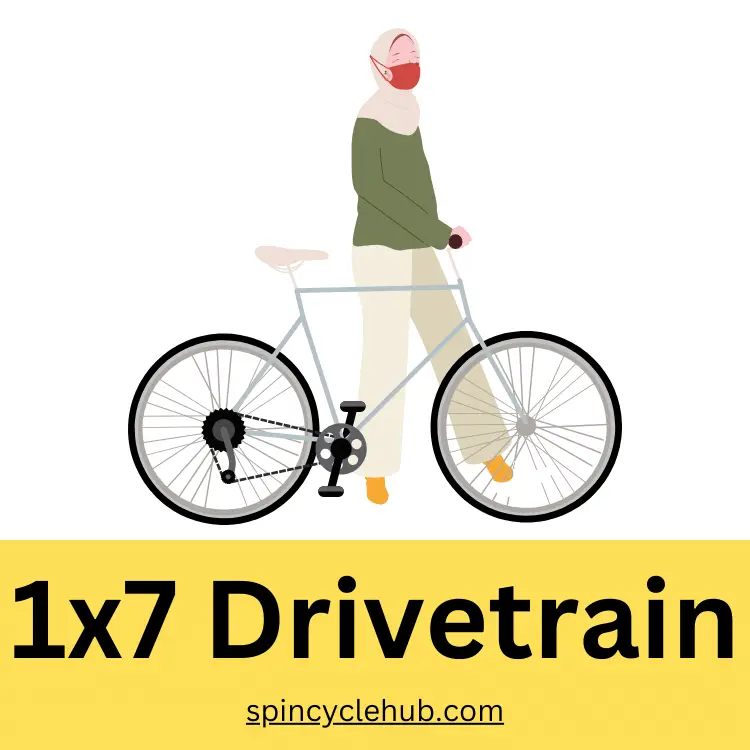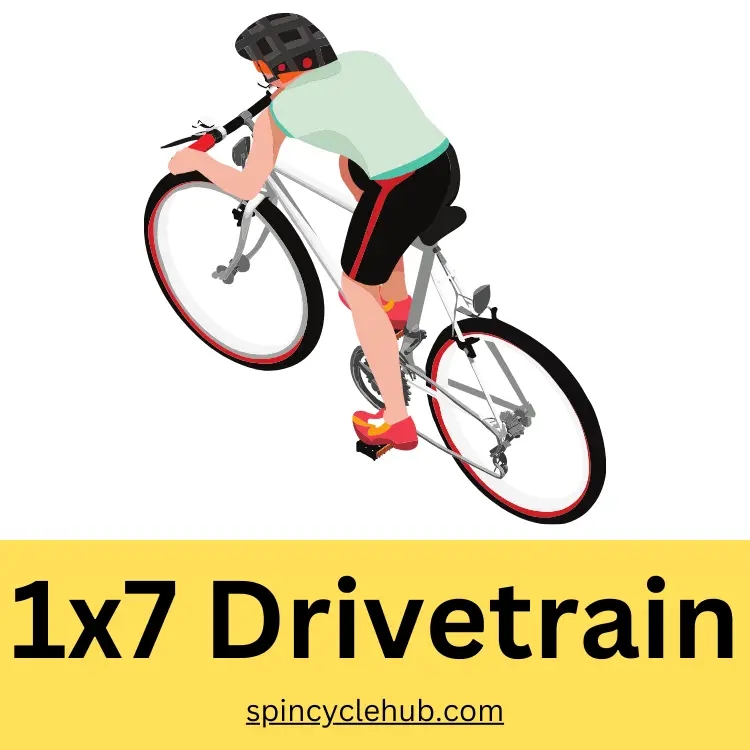Introduction: Unveiling the Marvels of the 1×7 Drivetrain
So, you’ve heard whispers in the biking community about the 1×7 drivetrain. Wondering what all the buzz is about? Well, buckle up (or should I say pedal up?) because we’re about to take a deep dive into this revolutionary piece of biking tech.

What Exactly is a Drivetrain?
Before we jump headfirst into the world of 1×7 drivetrains, let’s make sure we’re all on the same page. A drivetrain is basically the system that transmits power from your legs to the wheels of your bike. It’s composed of various components including the chain, cassette, crankset, and derailleurs.
The Traditional vs. the 1×7: What’s the Difference?
Alright, picture this: you’re cruising down a trail, tackling steep inclines and sharp turns. With a traditional drivetrain, you might find yourself constantly shifting gears to find that sweet spot of efficiency and power. But with a 1×7 drivetrain, things are a bit simpler.
Traditional Drivetrain Woes
So, let’s talk about the headache that is a traditional drivetrain. You’ve got a front derailleur with multiple chainrings, and a rear derailleur with a hefty cassette sporting a gazillion gears. It’s like trying to juggle while riding a unicycle – confusing and exhausting!
Enter: The 1×7 Drivetrain
Now, imagine shedding all that excess gear and embracing simplicity. That’s what the 1×7 drivetrain offers. With just a single chainring up front and a 7-speed cassette at the back, it’s like switching from a cluttered workspace to a minimalist zen den.
Why Go 1×7?
Ah, the million-dollar question: why should you hop aboard the 1×7 train? Well, let me break it down for you.
Simplified Shifting
Say goodbye to the constant gear-hunting dance. With fewer gears to fuss over, shifting becomes a breeze. Whether you’re climbing a hill or sprinting on flat terrain, finding the right gear is as easy as pie.
Weight Reduction
Who doesn’t love shedding a few pounds? By ditching the front derailleur and extra chainrings, you’re trimming down the weight of your bike. That means easier climbs and faster acceleration – a win-win in my book!
Less Maintenance, More Riding
Let’s face it – bike maintenance isn’t the most exciting part of the biking experience. With fewer components in your drivetrain, there’s less to clean, adjust, and replace. That means more time on the trails and less time tinkering in the garage.
But Is It Right for You?
Now, before you go swapping out your trusty old drivetrain for a shiny new 1×7 setup, let’s consider a few factors.
Terrain and Riding Style
Are you a downhill demon or a cross-country crusader? Your choice of terrain and riding style can influence whether a 1×7 drivetrain is the right fit for you. While it’s great for simplicity and weight savings, it may not offer the gear range needed for extreme climbs or descents.
Budget Considerations
Let’s be real – biking can be an expensive hobby. Before making any upgrades, it’s essential to consider your budget. While the 1×7 drivetrain offers numerous benefits, it may come with a hefty price tag compared to traditional setups.
Comparing Traditional and 1×7 Drivetrains: A Side-by-Side Showdown
Now that we’ve got the basics down, let’s compare the traditional and 1×7 drivetrains head-to-head. Strap in (or clip in) folks – it’s about to get technical!
| Aspect | Traditional Drivetrain | 1×7 Drivetrain |
|---|---|---|
| Number of Gears | Multiple (Usually 2 or 3 chainrings, 7-12 cogs) | 7 Gears |
| Gear Range | Wide range for various terrains | Narrower range, suitable for specific terrain |
| Weight | Heavier due to multiple components | Lighter due to simplified setup |
| Complexity | More components, more maintenance | Fewer components, less maintenance |
| Cost | Typically cheaper upfront | May be pricier due to specialized components |
The Verdict
So, which drivetrain reigns supreme? Well, it depends on your priorities and riding preferences. If you crave simplicity and weight savings, the 1×7 drivetrain might be your new best friend. But if you need a broader gear range for tackling diverse terrain, the traditional setup could still be the way to go.

Conclusion: Riding into the Future with 1×7
And there you have it – a crash course (hopefully not literally) on the 1×7 drivetrain. Whether you’re a seasoned pro or a newbie on two wheels, it’s worth considering this innovative piece of biking tech for your next upgrade. With simplified shifting, weight reduction, and less maintenance, it’s a game-changer for riders seeking efficiency and performance.
FAQs (Frequently Asked Questions)
Q1. Can I retrofit my current bike with a 1×7 drivetrain?
Retrofitting your bike with a 1×7 drivetrain is possible, but it may require some modifications depending on your bike’s compatibility.
Q2. Will I notice a significant difference in performance with a 1×7 drivetrain?
While individual experiences may vary, many riders report improved shifting efficiency and reduced weight with a 1×7 setup.
Q3. Are there any drawbacks to using a 1×7 drivetrain?
Some riders may find the narrower gear range limiting, especially for extreme climbs or descents. Additionally, the upfront cost of upgrading to a 1×7 drivetrain may deter budget-conscious cyclists.
Q4. Can I mix and match components from different brands when building a 1×7 drivetrain?
It’s possible to mix and match components, but compatibility issues may arise. It’s best to consult with a bike mechanic or do thorough research before making any purchases.
Q5. How often should I maintain my 1×7 drivetrain?
While the reduced complexity of a 1×7 drivetrain means less frequent maintenance, it’s still important to regularly clean and lubricate your chain and cassette to ensure optimal performance and longevity.
- Pinkbike’s Guide to Drivetrains: This comprehensive guide from Pinkbike offers insights into various types of drivetrains, including 1×7 setups, and provides additional information on their benefits and considerations.
You May Also Like
- Unlocking the Adventure: Exploring the Felt Z70 Road Bike
- Unlocking the Sweetness: Exploring the Cinelli Tiramisu Bicycle
- Unleashing the Power of Trek 2200 Composite
- Trek Bikes 830: Your Ultimate Guide to Riding in Style



